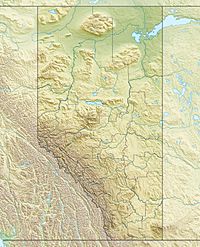Mount Palmer (Alberta) facts for kids
Quick facts for kids Mount Palmer |
|
|---|---|
| Highest point | |
| Elevation | 3,150 m (10,330 ft) |
| Prominence | 270 m (890 ft) |
| Listing | Mountains of Alberta |
| Geography | |
| Country | Canada |
| Province | Alberta |
| Parent range | Winston Churchill Range |
| Protected area | Jasper National Park |
| Topo map | NTS 83C5 Fortress Lake |
| Climbing | |
| First ascent | 1953 by G. Harr, G. Roberts, Mr. and Mrs. Mendenhall, R. Van Aken |
| Easiest route | rock/snow climb |
Mount Palmer is a tall mountain located in the beautiful Athabasca River Valley. You can find it inside Jasper National Park in Alberta, Canada. This mountain is part of the impressive Winston Churchill Range, which is a section of the larger Canadian Rockies mountain chain.
Contents
About Mount Palmer
Mount Palmer stands at an elevation of 3,150 meters (about 10,335 feet) above sea level. This makes it one of the many high peaks in the Canadian Rockies. It is located southeast of a place called Gong Lake.
How Mount Palmer Got Its Name
The mountain was named after an American explorer named Howard Palmer. He explored mountains in the early 1900s, especially in the Selkirks and the Canadian Rockies. Naming mountains after important explorers is a way to remember their contributions to discovering and mapping new areas.
First Climbers
The first time people successfully climbed to the top of Mount Palmer was in 1953. The climbing team included G. Harr, G. Roberts, Mr. and Mrs. Mendenhall, and R. Van Aken. The easiest way to climb Mount Palmer involves a mix of rock and snow climbing.
Jasper National Park
Mount Palmer is located within Jasper National Park. This park is a very important protected area in Canada. It is known for its stunning mountains, glaciers, forests, and wildlife.
Why National Parks Are Important
National parks like Jasper are created to protect nature and wildlife. They also allow people to visit and enjoy the outdoors in a safe and responsible way. These parks help keep the environment healthy for future generations.


